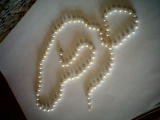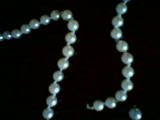B
bizzymom
Guest
My husband gave me a strand of pearls for Christmas which he bought from a friend of his. He was told they are Tahitian pearls and they are "natural," not cultured. They are whitish in color and are I think he said 5.5-6.5 in size, and there are 99 pearls on the strand, tied between each pearl, with an 18 karat gold clasp. I have done the "tooth test" and they appear to be real.
First, how can I tell if they truly are "natural" pearls and not cultured? I've tried peering down in the hole but can't see down there, these strand is in perfect shape and the silk isn't stretched at all.
Secondly can anyone give me an approximate value if they are natural and also a value if they would turn out to be cultured?
They were bought by this friend of his back in the early 1980s and this friend did jewelry reselling at that time to the upper crust, doctors, lawyers, etc.
I don't know how much my husband paid for them but I'd like to know an approximate value (before I go to the jeweler to have them appraised).
Thank you for any help you can give me.
First, how can I tell if they truly are "natural" pearls and not cultured? I've tried peering down in the hole but can't see down there, these strand is in perfect shape and the silk isn't stretched at all.
Secondly can anyone give me an approximate value if they are natural and also a value if they would turn out to be cultured?
They were bought by this friend of his back in the early 1980s and this friend did jewelry reselling at that time to the upper crust, doctors, lawyers, etc.
I don't know how much my husband paid for them but I'd like to know an approximate value (before I go to the jeweler to have them appraised).
Thank you for any help you can give me.


